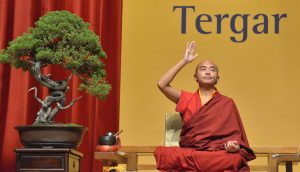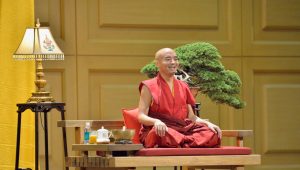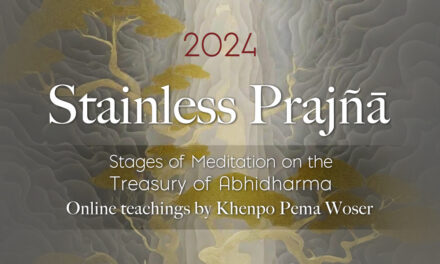 ▍What is “Joy of Living”?
▍What is “Joy of Living”?
Joy of Living means living our life joyfully.
So how can we live our lives with joy? There are two important things here. Firstly, we need to discover our basic innate goodness, which is our true nature, and to explore “Who we are?”.
The problem is that we are often looking for real happiness out there. When we look outside, we may find happiness temporarily. We may find happiness from wealth, fame, power, and the environment, but these are all temporary. Then our happiness becomes like the stock market, or it becomes like the waves of the ocean.
Actually, we are already wonderful and freedom is with us all the time. That basic innate goodness is who we are. All these wonderful qualities are right now with us, within all of us. We all have this basic innate goodness or what we call the enlightened nature within all of us but the problem is that we do not recognize this.
Secondly, we need to make everything our friend, as the cause of happiness and liberation. We can use all objects to explore our innate qualities. These objects can be obstacles, suffering, negative emotions, forms, sound, smell and taste. All these objects can help us link with our innate qualities and turn all obstacles into opportunities, turning problems into solutions.
▍Too close and we do not see; too easy and we do not believe it.
Joy of Living level 1 to level 3 can help us recognize three innate qualities which are with us 24 hours a day. They are 1. awareness, 2. love and compassion, and 3. wisdom.
Joy of Living level 1 is about “Awareness”. So, what is awareness?
Awareness is the knowing, which is already there within you. However, since this quality is too close to us, we cannot see it. Also, it is too easy and therefore hard to believe.
I have some question for all of you: How many of you can see my hand?
Okay so you if you can see please say “yes”. [According to the poll], 99% of you can see. So, that is awareness.
And another question is, how many of you can hear the sound? [Rinpoche is snapping his fingers]. There are 100% of you who can hear, so that is awareness. And today nobody said that they cannot hear. Even if someone were to say that they cannot hear, that is also awareness because they are aware of “cannot hear”, and that is awareness.
This knowing is basically your own mind. If you are not unconscious you have mind, right? You are not a rock and you have consciousness. Through this mind, you can see, hear, have thoughts and emotions. So, the mind has the ability to see, hear, feel and think. That is awareness and sometimes we call it clarity or luminosity.
When we begin to know how to be with our own mind, we can then understand. Actually, the fundamental quality of this mind is wonderful, and this awareness is totally free. The awareness is pure, it is with us all the time and is always present. Awareness will never be trapped and it is always free.
▍Through meditation, connect with the pure and free “sky”.
In a traditional example, we liken the fundamental quality of awareness to the sky. Our thoughts, emotions, perception, seeing things, hearing things, feeling taste and smell – all these are what we call clouds in the sky.
So normally what we see are only thoughts, emotions, feelings, and then the perceptions. From the eyes, we can see; from the ear, we hear sound; from the nose we smell; from the tongue, we taste and from the body, we have sensations. We do not see the fundamental qualities but only see the cloud. We do not see the sky, which is a foundational quality.
The purpose of Joy of Living level 1 is for us to gradually connect with the awareness itself, that is, to connect with the sky itself.
What is meditation about? What is the essence of meditation? These are views from the intellectual level. So now that we know that the essence of meditation is awareness, how can we bring that view into the experiential level? We need to do this through actual practice and that is meditation.
▍Realizing having more thoughts is a good sign!
If you are new to meditation, it is normal to have ups and downs at the beginning of the practice.
At the beginning you may feel like it is not meaningful or making sense to meditate. When you practice again and again, then one day you may have some taste of meditation and feel quite happy and joyful and think “now I’m really learning meditation”.
After this feeling of calmness and peace, you realize that a lot of thoughts and emotions come and looks like it is becoming worse than before. What is the reason for that?
Using an analogy, if there is a river in the mountain and the river is muddy, you cannot see fish in the river. When the river becomes calmer and cleaner, you realize there are a lot of fish in the river. Actually, the fish was there the whole time but you did not see the fish because of the muddy water. Now you see a lot of fish in the river when river becomes calm and clear.
The same thing applies here with meditation. When we meditate, our mind begins to be calm and peaceful. Therefore, at the beginning it looks like there are a lot of thoughts and emotions. If you feel like you have more thoughts and emotion or feel like you are getting worse, then these are actually good signs!
▍Being with the nature of reality, this is the beginning of wisdom
So here in Joy of Living level 1, we learn different meditation techniques, including meditation with form, sound, smell, taste, sensation, and pain.
With awareness, right is ok, wrong is ok, happy is ok, not happy is also ok. Everything is ok.
When we can be friends with everything, what is the use of resistance, hatred, or aversion? This aversion will be freed, and attachment and grasping also will be freed.
The root of attachment and aversion is ignorance, which means not seeing the nature of reality. When we can be with form, sound, smell, taste, and sensation as they are, then we can be with the nature of reality, and that is the beginning of wisdom.
When we begin to have wisdom, ignorance begins to dissolve. So what we call the three poisons or the three roots of suffering – ignorance, aversion and craving – they will also dissolve.
▍The two dimensions of the luminosity of mind.
Awareness has the same meaning here as your mind consciousness. This mind is like a lamp. A lamp has two qualities.
1. Self-luminosity
The lamp illuminates itself. So if there is a flame then the flame is the light. You don’t need to use a flash light to see the flame because it illuminates itself.
2. Illuminating others
If you light the lamp in the dark room, it illuminates everything in the room and you can see everything in the room because of it.
Similarly, you can see me, hear my voice, smell the scent or have the sensation of everything here, these are all because of the aspect of mind that it can illuminate others. It also includes having thoughts and emotions. Without this mind, these are not possible.
And at the same time, mind itself is luminosity, awareness, and consciousness. Even when there is no object, it can still know itself, this is the aspect of mind that is illuminating itself.
▍What is the difference between ordinary awareness and meditative awareness? Please explain more.
Ordinary Awareness:
Normal awareness is when we have not recognized awareness and have not received the introduction to awareness.
Meditative Awareness:
After we recognize awareness, you will develop the motivation and intention of meditating on the form, sound, smell, and taste. With this intention, you can bring view into awareness, thus turning it into meditative awareness.
“Awareness” is “Mind” and there are two definitions of mind:
1. Clear
Everything is visible to the mind. Through the eyes you can see; through the ears you can hear. Everything becomes visible for you because of the manifestation of this clarity.
2. Knowing
You “know” what they are.
But only “knowing” is not enough. We need to bring it into practice. The practice we did at the beginning with sound, knowing sound, being with the sound, being with the sound together… Then you will develop more and more connections to the awareness itself and the recognition of awareness.
So the difference between ordinary or normal awareness and meditative awareness is whether you “recognize” awareness or not. There is meditative awareness when you recognize and maintain that recognition with objects or without object.
▍How do we free ourselves from the roots of suffering through meditation?
In the Four Noble Truths, it is mentioned:
1. First is to get to know and understand the suffering.
2. Second is to understand the causes of suffering.
3. Third is freedom or liberation.
4. Fourth is the path.
So during sound meditation, when we practice being with sound as it is, we do not do anything but just listening. At that moment, we are connecting with the truth of reality
Also, we let go of choosing good sound and bad sound but just “knowing” sound. Then all sound can become the support of our meditation.
Truly knowing sound and just being with sound, this is wisdom.
Letting go of aversion of any sound and accepting all sounds, this is loving-kindness compassion.
Not seeking perfect sound or attached to any specific sounds, this is letting go.
So then, the roots of suffering – attachment, aversion, and ignorance- are then liberated by this particular meditation.


